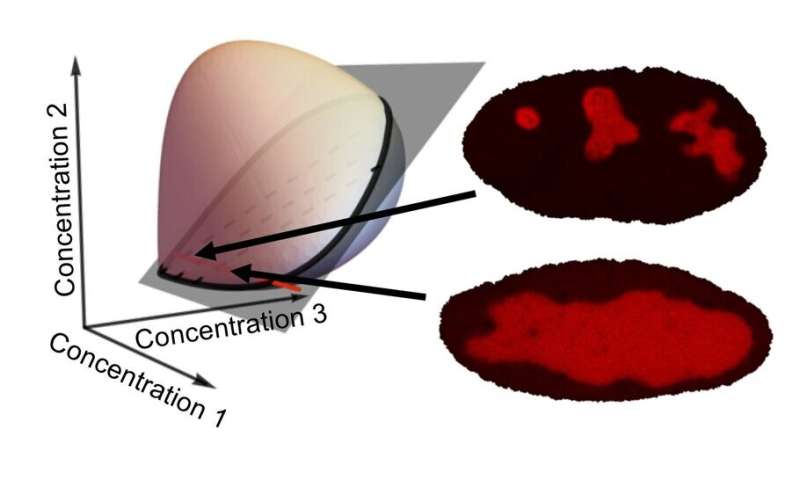New rules for the physical basis of cellular organelle composition

New findings about critical cellular structures have upended common assumptions about their formation and composition and provided new insight how molecular machines are built in living cells.
Organelles are the cell's organ-like compartments, which are implicated in many cellular functions including the formation of critical cellular machinery, while also having implications for disease and pathology. A large class of organelles can form without the need for membrane boundaries, and are increasingly referred to as condensates because they are widely believed to form through liquid condensation, like dew drops on grass. But since these organelles have no walls, researchers still do not understand the rules that govern what molecules get into condensates, and what are excluded.
One prediction of the liquid condensation model is that these structures form when the concentration of proteins and other biomolecules becomes high enough to cause them to "condense" from within the surrounding cellular milieu. "It's like adding salt to water. Salt goes into solution; but if you add enough, at some point it stops and salt crystals drop out," said Joshua A. Riback, a postdoctoral researcher in chemical and biological engineering at Princeton University and the article's co-first author, together with former graduate researcher Lian Zhu. "But when we looked at it, we found this is not the case."
The findings, by a researchers at Princeton and the St. Jude Children's Research Hospital in Memphis, were published online May 6 in the journal Nature.
Working with colleagues led by Clifford Brangwynne, a professor of chemical and biological engineering at Princeton and an Investigator at the Howard Hughes Medical Institute, Riback and Zhu found that the formation of the condensates also heavily depended on multiple compounds present in the cell. Researchers previously believed that condensates formed when enough of a single biomolecule, such as protein or RNA accumulated in cells. But the answer is more interesting than that.
"The ratio of different types of biomolecules is very important," Riback said. "It's called compositional dependence."
Or in Brangwynne's analogy: "It's like cooking: did I add too much salt to this recipe? Well, it depends on how many onions are in the pot already!"
One reason for the compositional dependence is the way that proteins and RNA interact at the molecular level. Condensates require a certain amount of interactions, which depends on the types of biomolecules and their compositions. The researchers found that interactions between different types of molecules, or heterotypic interactions, were essential for driving the formation of these structures. Too low or two high of a composition of one biomolecule limits the number of heterotypic interactions which can form.
The researchers demonstrated the importance of this composition dependence for the assembly of critical molecular machines in cells. One example is the creation of the ribosome—critical for the production of all protein in the cell—which form in liquid condensates called nucleoli. Riback said the formation of ribosomal subunits is similar to folding origami. When the shape is complete, the ribosomal subunit no longer has enough available regions which can form connections that make it stick to the surrounding liquid within nucleoli. So, it is ejected, allowing it to go out and perform its function throughout the cell.
"As the RNA folds into the origami swan, it can no longer contribute," Riback said. "So if it is properly folded, it is expelled."
Richard Kriwacki, a co-principal researcher for the project, said the findings provide important insight for cellular biology.
"This study highlights how the process of phase separation enables a complex membraneless organelle such as the nucleolus to respond to changing cellular conditions by linking its protein composition to its own functional output, ribosomes, which are the molecular machines that synthesize proteins," said Kriwacki, a member of the St. Jude faculty and co-leader of its Cancer Biology Program. "Our data suggest that, as nucleolar protein synthesis varies in cells, phase separation helps control nucleolar structure, dynamics and function."
The researchers performed the experiments by tagging proteins with fluorescent markers and using the fluorescence to see how varying the protein concentration affected condensates' formation. Riback said the inspiration for the experiment came after they tried to increase the size of condensates by triggering cells to over-express certain types of proteins. When this changed the composition and stability of the condensates, they began to examine the cause.
"I wanted to understand how proteins formed condensates," he said. "It turned out to be a lot more complicated in cells then in the test tube."
More information: Composition-dependent thermodynamics of intracellular phase separation, Nature (2020). DOI: 10.1038/s41586-020-2256-2 , www.nature.com/articles/s41586-020-2256-2
Journal information: Nature
Provided by Princeton University




















